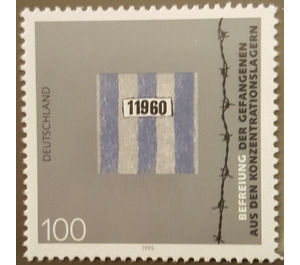block stamp: 50th anniversary the liberation of prisoners from the concentration camps - Germany / Federal Republic of Germany 1995 - 100 Pfennig
Theme: Calender
| Country | Germany / Federal Republic of Germany |
| Issue Date | 1995 |
| Face Value | 100.00 |
| Color | grey |
| Perforation | Ks 13 3/4 |
| Printing Type | Multicolor offset printing |
| Stamp Type | Postage stamp |
| Item Type | Stamp |
| Chronological Issue Number | 1669 |
| Chronological Chapter | GER-BRD |
| SID | 997759 |
| In 34 Wishlists | |
Concentration camps were developed by the National Socialists into a system with the highest perfection of elimination of opponents of the regime and of all otherwise unpleasant persons - up to the annihilation of entire peoples. With the beginning of the Second World War, the concentration camp system was considerably expanded. Numerous new camps emerged in the conquered Polish territories. Among them, the concentration camp Auschwitz has become the largest death camp in world history in both its spatial extent and its capacity for destruction. The number of concentration camps grew to 22 during the war, with 165 labor camps. In the camps, the prisoners were helplessly exposed to the brutal arbitrariness of the guards. Due to the ruthless exploitation of the prisoners in the warehouses and armaments factories associated with the camps with eleven-hour working hours with completely insufficient nutrition under constant bullying, for hours of order appeals and by epidemics, the mortality among the camp inmates was extraordinarily high. At the Wannsee Conference on January 20, 1942, the destruction of European Jewry was determined organizationally. The transports of European Jews to the East decided exclusively on the Belzec, Chelmno, Lublin-Majdanek, Sobibor, Treblinka and Auschwitz-Birkenau extermination camps. The total number of Nazis detained in the concentration camps is estimated at 7.2 million, of which only about 500,000 survived. (Text: Federal Agency for Civic Education, Bonn)



